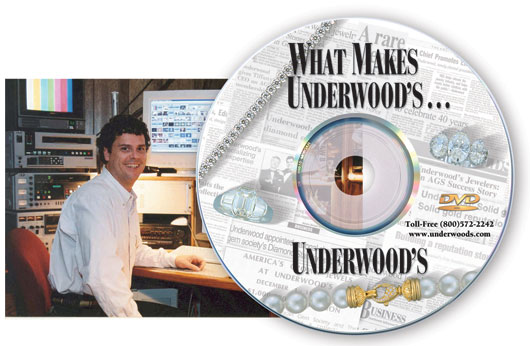Companies doing things right.
[h3]Underwood Jewelers; Fayetteville, AR[/h3]
 [dropcap cap=F]ifteen years ago, most young men making videos were doing so to promote their struggling rock bands. Not Craig Underwood. While he was making videos, too, his were to help him sell more rocks.[/dropcap]
[dropcap cap=F]ifteen years ago, most young men making videos were doing so to promote their struggling rock bands. Not Craig Underwood. While he was making videos, too, his were to help him sell more rocks.[/dropcap]
[componentheading]THE IDEA[/componentheading]
The young executive-in-training and his father produced a hugely successful direct-mail video catalog in the early 1990’s. More recently, the video catalog has morphed into a television documentary. Since the catalog campaign’s start, Underwood’s has experienced a fourfold increase in custom jewelry orders that has tripled the store’s sales volume.
Like many paradigm-shifting ideas, this one came from another industry. On his way home from an AGS Conclave in the late 1980’s, Underwood read in a magazine about a group of realtors who were selling high-end properties with then-cutting-edge video technology. He decided that between his own fascination with electronics and his father’s interest in television commercial production, the father and son duo (and store staff) could produce a video catalog in time for Christmas 1991.
[componentheading]THE EXECUTION[/componentheading]
Advertisement
Since then, the Underwoods have upgraded video production equipment and refined the annual ritual of producing their video. Each July, a new theme is decided on and copywriting starts the following month. By September, product shooting begins and the long process of video editing goes on through October to meet the Thanksgiving Day weekend deadline.
Underwood, his father and the entire staff do everything — from voice-overs and copywriting, to shooting product stills and video editing. A total of 700 man hours go into producing the 30-minute video. The cost to produce the video in-house is “difficult to add up,” says Underwood. “But if a jeweler was to hire a company to do this, the cost would be astronomical — easily six-figures.”
Back in the early 1990’s, the Underwood’s intent was to use the marketing videos to educate and inform customers about gems and jewelry while promoting the store’s custom jewelry work. The response to their first video was phenomenal.
“In [November] 1991, we mailed out 900 videos to our top customers,” Underwood says. “The response was so good, we actually had to stop advertising for the nine months that followed so we could catch up with the backlog of custom jewelry work.”
As a pioneer in direct-mail video catalogs, Underwood’s campaign caught the attention of Dr. Ken Clow. The University of Arkansas professor volunteered to do extensive market research to determine the effectiveness of Underwood’s first direct mail video catalog campaign.

Advertisement
[componentheading]THE REWARDS[/componentheading]
Completed in 1992, the research indicated that 75% of the people who received the video watched it at least one time. Of that 75%, 89% watched the entire video. Roughly 43% of the overall survey respondents watched the video more than once and 66% watched it with their spouse. About 31% of the people surveyed said the video strongly influenced them to make a jewelry purchase or visit the store. And, 32% of respondents stated they made an actual purchase within six months of receiving the video. In direct marketing terms, this qualifies as a grand-slam home run.
In 1998, timing and good fortune would once again grace the Underwoods and their chosen promotional medium. A local major network affiliate program director had seen the Underwoods’ video. He contacted the jeweler to see if they’d be interested in buying an open 30-minute slot in the lead-up to the holidays. The Underwoods went for the deal.
So now, with their video being frequently broadcast, and the direct-mail campaign continuing, Underwoods should have had more business than they could handle, right? Unfortunately not. Says Underwood: “In early 2002, as we did our annual review and evaluation of our marketing, we came to the conclusion that while the video was still much more effective than a direct-mail printed catalog, the novelty [of the video catalog] had worn off. At that point, we revisited the idea of broadcasting the video, but we knew from our previous experience that we would need to re-work the catalog format to make it TV-ready.”
Underwood totally reworked the annual video — turning it from more of a catalog into a documentary about the store, its people, and its services — including the store’s popular custom design work.
The video format wasn’t the only change. Moving from a direct-mail campaign sent mainly to Underwood’s customer base to a more general, public promotion required a newspaper campaign to let people know when the documentary would appear on TV.
“We listed the TV [spots] schedule and mixed in some product shots plus some ad copy in a bullet-point format,” says Underwood. “But the one column by 21-inch ad was a unique format that caught everyone’s eye and got prime placement on right-hand pages in our newspaper campaign.”
Advertisement
In 2002, Underwood purchased a total of 12 time slots. Over the last three years, he has increased that number to a total 17 time slots, and now has five TV advertisements to promote the documentary — three of which would air during prime time. This was an inexpensive deal-sweetener Underwood negotiated into the contract.
Dedicated to keeping the tradition of annual videos up to date with the latest technological advances, Underwood’s next logical step will be moving into online streaming video. With broadband Net access becoming increasingly common, Underwood has already started exploring Internet options. “Even with broadband, the quality isn’t where we want it,” says Underwood. “Like all of our promotions, we want the streaming video to be high quality. Perhaps next year we’ll have this portion of the video campaign where we want it.”
[span class=note]This story is from the December 2005 edition of INSTORE[/span]